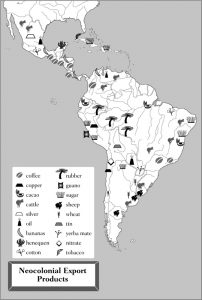This week we are looking at modernity and what that looks like in Latin America. We will begin to look at economics and the introduction of technology and how they contribute to the integration of modernity.
Look at our technology today, from the accessibility and growing necessity of the internet to our dependence on smartphones and social media. It is crazy to think that in the pandemic we are in today we still have the ability to attend classes and continue some jobs via the internet. There was a time when this would not have been possible because there wasn’t the advancement of things like skype, facetime, google meet, zoom and many more. At this point, K-12 students would have lost or been delayed almost a year of education, and they would not have been able to continue until the pandemic ended. The adults who had to attend work to support their family would have been unemployed and left looking for a job.

With the introduction of modernization to the post-colonial world, new jobs and careers were introduced. These new jobs created the middle class. No more was the simple divisions of the rich or the poor. Now the poor class had the ability to grow and get higher-paying jobs and move into this new growing middle class. Society was becoming more complex.
Let’s begin by classifying the ways modernity can present itself. Dominant modernity is the current way of being. Residual modernity is what’s left of how it was in the past. Finally, emergent modernity is what might come in the future. Some examples that I think would fit the description of dominant modernity is the integration or the internet, social media, social justice, consumerism (it has at least increased with online shopping and retailers like Amazon) entrepreneurs (more and more people are choosing to start their own business and or choose other forms of ‘unconventional’ jobs [ie streamers, social media consultants, influencers, creating and selling your own products). For some reason I am having troubles coming up with a residual form of modernity, I was thinking that maybe the consumer industry can be considered as also being residual from the beginning of modernization. The consumer industry has changed a lot since then, today we can look for what we want from our smartphones and purchase it right at our fingertips without having to leave our homes. What were some residual modernities did you come up with? Some examples of emergent modernity are social accountability and demanding social change, I think that this has become more apparent in the last few years.
Modernity brought to Latin America the ability to participate in the export and import trade. It allowed them to participate in the emerging consumer lifestyles, by selling or trading their natural resources and thus growing their economy. Haiti had a big part in helping the rest of the world develop. Haiti put the work in but they themselves were left behind by the rest of the world. Latin America has been developing at different rates all over; modernized cities are right next to underdeveloped towns.

Exports from the Americas
It’s interesting to learn that Latin America had the most to gain from the export boom, but did not have the resources to transport any of it. The above image (From this week’s resources) illustrates what Latin America had to offer to the rest world. If they had a way of exporting their goods they would be in a better economic position. The solution to this problem was to take the help of the northern countries that needed the natural goods Latin America had, and accept the technology and resources the north had in return. This resulted in the productions of railways that would allow goods to be exported out of Latin America and to the north. In exchange, Latin America gained things like barbed wire, shoes, machine guns, home appliances, radio, cameras. etc.
Without outside help, Latin America would have had a difficult time evolving into modernity. How would the world be today if Latin America didn’t evolve with the rest of the world? How much harder would attaining resources and natural goods for the rest of the world if Latin America didn’t accept the help. Would the consumer industry be delayed, and possibly an emerging modernity for us today?
What are other examples of modernity did you think of? Do you think that we would be where we are today if Latin America delayed the construction of railways until they could afford them themselves?
Sarita 🙂


Hi Sarita, thanks for your blog!
As for your question, I don’t think we would be the same way we are today if the construction of railways in Latin America was delayed. As you mentioned, other countries needed the natural resources that Latin America had, and without it, they wouldn’t have developed the same way. Of course, if that had happened to be the case, that Latin America refused exterior help, I imagine they would have figured out another way to trade the natural resources.
Personally, I think it’s more a question of, why did western-northern countries develop modernity in great feats in comparison to Latin America, that had originally a lot to gain from the export boom as well?
Hi Sarita. It may help your perplexity to realize that in the lecture (where I took these terms from the critic Raymond Williams), I wasn’t talking about “dominant,” “residual,” and “emergent” modernities. These three categories are just another way of thinking about social change. The “residual” may well be what we otherwise think of a “pre-modern,” for instance.